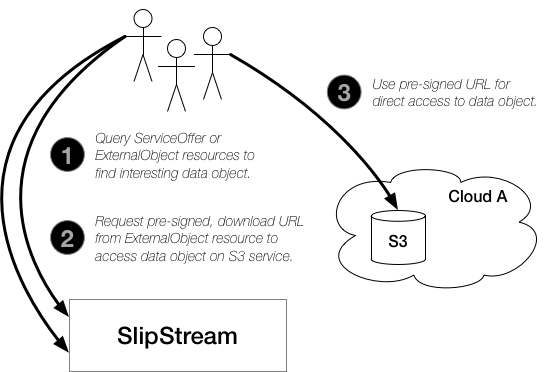Data Management Model¶
The SlipStream multi-cloud object storage provides Write-Once, Read-Mostly (WORM) semantics. That is, a particular object is created, populated with data, and then remains immutable for the rest of its lifecycle. This makes strategies for replication and caching easier to implement.
Model Entities¶
The full data management model contains three entities that interact to provide all the stated benefits:
- S3 object storage on the supported cloud infrastructures,
- ExternalObject resources within SlipStream that provide links to the real data objects in the S3 object storage, and
- ServiceOffer resources that optionally provide rich, user-defined metadata for an object or set of objects.
For efficiency, all IO operations on a data object occur directly between the client and the S3 object store containing the object. In contrast, the management functions (creating, updating properties, and deleting) are handled through SlipStream via the standard CIMI CRUD actions on the data object’s ExternalObject and/or ServiceOffer resource.
Operations¶
Accessing a data object follows the simple, three-step process shown in the following diagram.
The process for creating data objects is similarly easy:
- Create ExternalObject resource in SlipStream,
- Request a pre-signed upload URL,
- Upload the data, and
- Mark the ExternalObject as “ready”.
Here, the explicit state change of the object to “ready” allows the owner of the object to indicate when the object is ready for consumption by others.
Deleting an object is a single step process that synchonizes the deletion of the metadata and the actual object within the S3 storage.
Object Metadata¶
The metadata for objects is stored in SlipStream, either in ExternalObject or ServiceOffer resources.
For many, simple use cases, the attributes available on the ExternalObject resource will be sufficient. These attributes include a name, description, simple properties, bucket name, and object name.
For those use cases that require richer metadata, ServiceOffer resources can be used together with the ExternalObject resources. The open schema of the ServiceOffer resource allows any general or domain-specific attributes to be associated with the data objects and the standard CIMI filtering provides rich queries.
Authorization¶
Access to objects is controlled through SlipStream ACLs. Those users/roles with “modify” access to an object can upload data, download data, and delete the object. Those with “view” access can only download data. Any authenticated user can create an object.
